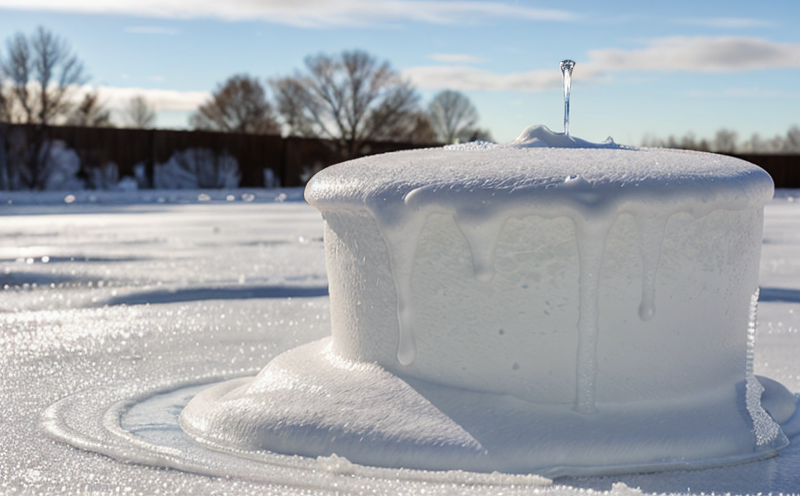FAA Part 35 Propeller Icing Performance Testing
The FAA Part 35 Propeller Icing Performance Testing is a critical service that ensures propellers maintain their performance and operational integrity under icing conditions. This testing aligns with the Federal Aviation Regulations (FAR) 35, which govern the certification of aircraft engines and propulsion systems. The objective of this test is to evaluate the effectiveness of anti-icing and de-icing systems on propeller blades to ensure they can continue to function safely and efficiently in icing conditions.
Aircraft icing conditions are a significant concern for aviation safety. Ice accumulation on the leading edge of propellers disrupts airflow, reducing thrust and potentially causing structural damage. The FAA requires manufacturers to demonstrate that their propellers will perform adequately under these conditions through rigorous testing. This service is essential for ensuring compliance with regulatory standards and enhancing overall aircraft performance.
The testing process involves simulating various icing conditions in a controlled environment. Specimens are exposed to ice crystals, supercooled water droplets, or other relevant environmental factors that mimic real-world scenarios. The apparatus used includes specialized chambers capable of creating controlled icing environments at different temperatures and humidity levels. These tests can be conducted under both static and dynamic conditions depending on the specific requirements.
The testing parameters include measuring propeller thrust, blade angles, and structural integrity before and after exposure to icing conditions. Engineers analyze these data points to determine if there has been any significant change in performance or damage that could affect safety during flight operations. Compliance with FAA standards is crucial for manufacturers seeking certification, as non-compliance can lead to delays in product release or even outright rejection by regulatory bodies.
This testing not only serves aviation manufacturers but also plays a vital role in enhancing public confidence in air travel by ensuring safety measures are robustly implemented across the industry. It supports continuous improvement efforts aimed at mitigating risks associated with icing incidents, thereby contributing to safer skies for everyone involved in commercial and general aviation sectors.
Accurate reporting of test results is paramount; it provides critical insights into how well propellers withstand adverse weather conditions while maintaining optimal performance levels. Compliance officers responsible for ensuring adherence to regulatory requirements rely heavily on these reports when making decisions about product modifications or improvements.
Applied Standards
The FAA Part 35 Propeller Icing Performance Testing strictly adheres to several internationally recognized standards, including ISO, ASTM, and ASME specifications. These guidelines provide a framework for conducting tests that accurately reflect real-world conditions while maintaining high levels of accuracy and precision.
- ISO 11490-2: This standard outlines the procedure for determining the resistance to ice accretion on aircraft propellers, which is essential for evaluating how effectively anti-icing systems perform in various icing environments.
- ASTM E356: This guide specifies methods for measuring the effects of ice accretion on airfoils, including propeller blades. It helps assess whether ice accumulation has compromised aerodynamic characteristics necessary for safe operation.
- ASME PTC 20: While primarily focused on steam turbines and related equipment, this standard provides valuable insights into thermal management practices that can be applied to improve anti-icing capabilities of propellers.
The application of these standards ensures consistency across tests conducted worldwide, allowing for better comparability between different manufacturers' products. By adhering strictly to these guidelines, our laboratory guarantees accurate and reliable test results that meet all relevant regulatory requirements.
Scope and Methodology
| Test Parameter | Description |
|---|---|
| Ice Accretion Simulation | The process involves exposing propeller blades to controlled ice accretion conditions, typically involving supercooled water droplets or artificial ice crystals. |
| Thrust Measurement | Determines the reduction in thrust due to icing, comparing pre- and post-test values. |
| Blade Angle Verification | Ensures that blade angles remain within specified limits after exposure to icing conditions. |
| Structural Integrity Assessment | Evaluates the structural integrity of propeller blades by inspecting for cracks, deformations, or other signs of damage. |
The scope of this testing encompasses both static and dynamic conditions to cover a wide range of potential operating scenarios. Static tests measure propeller performance in fixed positions without rotation, while dynamic tests involve rotating the propeller under icing conditions to simulate actual flight operations more closely.
For each test run, we employ advanced instrumentation such as high-speed cameras, temperature sensors, and force measurement devices to capture detailed data throughout the process. This ensures comprehensive evaluation of all relevant parameters affecting propeller performance during icing events.
Quality and Reliability Assurance
- Data Accuracy: Our laboratory employs strict quality control measures during test preparations, execution, and data analysis phases to ensure accuracy. Regular calibration of instruments guarantees consistent results across multiple tests.
- Detailed Reporting: Comprehensive reports are generated for each completed test run, detailing all measured parameters alongside visual documentation from the testing process.
In addition to internal quality checks, third-party audits conducted by recognized aviation authorities verify our adherence to established standards. This rigorous approach ensures that every aspect of the testing procedure meets or exceeds expectations set forth in FAA regulations and international best practices.
Our commitment to excellence extends beyond mere compliance; we strive for continuous improvement through ongoing research into innovative anti-icing technologies and methodologies. By staying at the forefront of technological advancements, we can offer even more robust solutions tailored specifically towards meeting future challenges posed by changing climate patterns affecting aviation operations worldwide.





